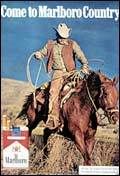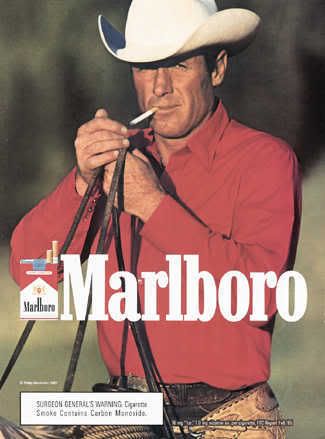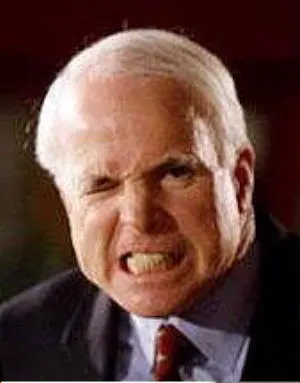
We have probably all seen the advertisement shown above. A rough and tumble cowboy riding his horse through wide-open country, he is free as a bird. Who would not want to light up a cigarette after seeing this advertisement of a good-looking cowboy of a man? The Marlboro man was introduced in 1955 to promote Marlboro cigarettes. The company was trying to appeal to a new audience of men. The Marlboro cowboy helped launch Marlboro as a brand and made Marlboro a whole lot of money. He not only launched them but also took them to the top. (npr.org) Good and bad effects have come out of the legendary image of the Marlboro cowboy.

Now this next picture that is shown above not everyone has seen before. This picture appeals more to your emotions when you see it. The well-developed pathos appeal develops into the parody and compare and contrast strategies, which all combine together to make an effective advertisement.
The anti-smoking ad is not your everyday picture that you see. With a bright blue sky in the background the orange desert really sticks out. A cowboy stands there alone with his horse next to him on the ground. The point of this advertisement is to hit you and make it count. One of the best ways to do this is to make the ad relatable. The most recognizable smoking icon is then used, the Marlboro cowboy. But instead of hurting him, they hurt the closest thing next to him, his horse. This ad wants to show you that you are not only hurting yourself when you light up; you are also hurting the people near and around you.
The pathos present in this picture is clearly stated by the horse lying there on the ground next to the saddened cowboy. The picture hits your emotions because it shows all the people you are endangering, besides yourself. The Marlboro man is still in perfect shape here but his horse was hit with horrible tragedy instead. “Marlboro Country” is emphasized in the first advertisement shown but the second advertisement shows you how maybe this make believe place is not what it really seems to be.
The pathos in the anti-smoking ad is exaggerated due to the scare tactic they are trying to put in place. This advertisement is trying to scare you out of smoking. The dead horse shows you what you can turn into if you start to smoke. The slippery slope that you can face if you start smoke is also addressed in this ad. First you start to smoke, then you get addicted, and then you die from smoking. The pathos has an ability to draw you in and make you feel for the cowboy because he has lost his horse. This relationship between the cowboy and his horse represents the way parents can hurt children so easily.


But the real pathos put in behind the scenes in the anti-smoking ad is only possible to see if you know the truth. Most people do not know that there actually was more than one Marlboro cowboy in these cigarette ads. Actually there were quite a few, from actors to real cowboys later on in the Marlboro campaign. Wayne McLaren (shown at right) and David McLean (shown at left were the two most famous of the cowboys, who both died of lung cancer at ages 51 and 73 respectively. Wayne McLaren actually appeared in front of legislature to promote a bill that would add taxes to cigarettes in order to support health education. McLaren also took a stance at a meeting for Phillip Morris stockholders to limit advertising. In an interview Wayne McLaren stated, "If I was responsible for making one person smoke, maybe I can be responsible for making two of them quit." (newyorktimes.com) David McLean on the other hand was the original Marlboro man. McLean started smoking when he was twelve years old in 1934. But vague warning labels about some risks of smoking weren’t even added until the 1960’s. These labels didn’t even warn about the nicotine addiction of cigarettes. (allbusiness.com) With all this truth now out in the air you can see the true emotions put behind the anti-smoking ad. In real life the horse doesn’t die, the cowboy does.
The anti-smoking ad is taking in the fact that you have seen the Marlboro man and his horse before. This familiar image of a cowboy and his horse is then given a spin of modern day reality. There are advertisements everywhere these days about all the dangers of smoking to the smoker and the smoker’s acquaintances. The anti-smoking ad took all this into mind when it made a parody of the Marlboro man. They took into the fact that this image is so familiar and people would know what it is. But they didn’t just put text across the top next to a normal Marlboro ad. No, they added to it by telling the true reality that happens when you light up. You hurt your family and your closest friends not just yourself.
This anti-smoking ad also exhibits comparison and contrast strategies. This advertisement cuts straight to the point. Right in the middle of the ad it states, “Second hand smoke kills.” There is no hinting around the subject, just going straight to the point. The Marlboro man was usually accompanied by his horse, so this makes the cowboy’s horse an easy target. The anti-smoking ad is showing the differences between the alive and the now dead horse from all the second hand smoke the cowboy gave him.
At first glance the pictures are both pretty similar. But once you take a deeper look into them you can see more of the differences. In the top picture the cowboy is in the beautiful country with nice tall grass all round him. Now take a look at the anti-smoking ad. The cowboy is in dry desert looking area. A more suffering environment with more miserable conditions is where the second scene takes place. This ad wants to point out to you that when you smoke you will suffer. But the first wants to point out to you that when you smoke you are in a great wonderful place, like a meadow of grass. The comparing of the pictures is simple to do because they both look like the average smoking advertisements you can see everyday. But as you take a look more into the environment of the pictures you can see the contrasting factors that are taking place in the anti-smoking ad.
Another big difference in the two ads is the emotions of the cowboys. The cowboy in the Marlboro ad is all saddled up and ready to take on the day with the chores he has set forth. But the anti-smoking ad cowboy is standing there with his head down and slumping. This cowboy is not in the mood to round up cattle because his horse has now left him. With the horse lying on the ground the cowboy is looking at it with sadness. These two differences in the cowboys show the two different points the ads are trying to get across.
Overall you can tell the effectiveness of the rhetorical strategies and appeals used in the anti-smoking advertisement. From pathos, parody, and compare and contrast, the point of the advertisement gets across. This is not any ordinary add that you see everyday; even though it might appear that way the first time you look at it. But further analysis shows all the thought and persuasive strategies that are put into the ad itself. At first glance the ad seems to have a comical feature to it and is telling you not to smoke for other’s sakes. But the underlying message that you can conclude to after the true history is revealed of the many Marlboro men. This history reveals the cause of their own death, which sadly resulted from the very product that they were getting paid to endorse in the first place.
Works Cited
Marchese, John. A Rough Ride." New York Times 13 Sept. 1992. http://query.nytimes.com/gst/fullpage.html? sec=health&res=9E0CE7DF1031F930A2575AC0A964958260
Schalch, Kathleen. "The Marlboro Man." 21 Oct. 2002. npr. 5 Apr 2008
"The Original "Marlboro Man" Dies from Lung Cancer Caused by Smoking; Family Sues Tobacco Companies for Fraud and Deceit." Business Wire 19 Sept.1996. http://www.allbusiness.com/legal/torts-wrongful-death/7269468-1.html.
